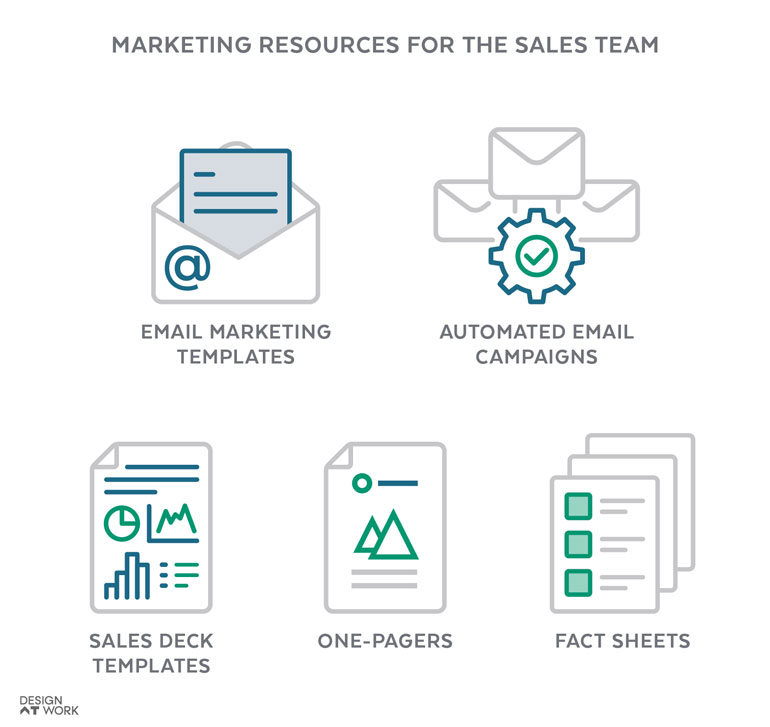Insights into how to bridge the gap between sales and marketing teams for greater impact.

Aligning your sales and marketing efforts — making sure teams are on the same page, speaking the same language and working toward shared goals — is essential for success. Not only is it important for building trust and improving efficiency, but it impacts the bottom line. It’s estimated that sales-marketing misalignment costs businesses over $1 trillion each year. Yet, as your business grows and your teams get larger, it becomes harder to keep these teams in sync.
Integrated marketing campaigns use a multi-pronged approach to raise brand awareness and connect with your target audience. But marketing campaigns don’t exist in a vacuum. Marketing can drive leads all day, but those leads need to convert to truly move the needle — and that’s where the sales team comes in. In the B2B industry, the average conversion rate is just 3.6 across all industries.2 When sales and marketing are misaligned, that percentage may be even lower, and your company is likely missing out on high-value opportunities. But the good news is that the flipside is true, too. When there’s synergy between these two teams, you’re likely to see a powerful impact on your conversions and growth.
In this article, we’ll take a closer look at how you can bridge the gap between sales and marketing. From brainstorming to sharing milestones, here are a few actionable steps that can help your teams work together.
Speak the same language.

One of the biggest hurdles in getting on the same page? Not speaking the same language. While teams may be talking about similar topics, they may use different terminology or language to mean the same thing. For example, “flysheets” and “one-pagers” may both refer to a single- or double-sided flyer. Or, vice versa, they may use the same vocabulary words to mean different things. For example, “conversions” likely refer to different goals for each team — marketing may use this term to refer to web traffic that completes a specific action like submitting a new business form, while sales may use this term to refer to the number of prospects who sign up for your service.
To get teams to speak the same language — and to truly understand each other — it can be helpful for them to spend time meeting regularly. For example, weekly or bi-weekly huddles can be used as a time to check in and connect, and shadowing sales calls or marketing strategy sessions can provide a firsthand view into the language each team uses day to day.
Crack the corporate lingo code.
It can be easy to get swept up in corporate lingo or industry jargon. But buzzwords and acronyms can make it much more difficult to connect with cross-functional teams. Instead of speaking in what is essentially code, when team members speak plainly using accessible language and take the time to explain acronyms to colleagues who may be unfamiliar with them, it goes a long way in improving communication. Explaining any department-specific acronyms or short-hand phrases will help both teams get on the same page.
Define milestones and metrics.

Another important way to build connection between the team is to define milestones, metrics and even shared goals. Clarifying the key performance indicators (KPIs) used to measure success provides insight into how both teams contribute to the overall goals — and how they can support one another. The teams can work together to strategize ways to achieve the defined KPIs and meet project milestones on a monthly, quarterly or annual basis. Not only does this support internal processes, but it has a major impact on your business’ bottom line. Companies typically see a 27% faster profit growth when sales and marketing teams work toward shared goals.3
Share customer insights.

Sales teams speak to prospective customers — so they understand the concerns and most common questions that arise. Their firsthand knowledge means that they know what terminology is being used by current and prospective customers. The marketing team can, in turn, use these valuable insights to align your company’s marketing initiatives with your ideal customers.
Marketing teams can take this information to address your customer’s specific needs — the challenges they’re encountering day to day, the benefits they’re looking for, what’s holding them back from making a purchase or signing up for your service. These factors can be addressed directly in the marketing materials, providing powerful and persuasive sales tools.
Collaborate on Campaigns.

A lot of strategy, effort and money goes into developing integrated, multi-platform marketing campaigns. But marketing is only one half of the battle. If the sales team is disconnected from the campaign goals, the potential for success diminishes. So rather than operating in silos, marketers can collaborate with the sales team to ensure they are not only informed but also connected with the company’s campaigns.
Brainstorm and idea share.
Marketers can bounce ideas off the sales team to get a better understanding of what might connect with customers. This can take many different forms — from structured meetings to freeform ideas sharing sessions — but, ultimately, the goal remains the same: to brainstorm ways to effectively communicate your value, services and products with your ideal audience.

Put the partnership into action.

Once your teams are on the same page, speaking the same language and working towards the same goals, it’s time to put things into motion. Here are some tools that marketers and creative teams can craft to help the sales team close more deals.

Email marketing templates and automations.
Ideal for both cold calls and warm lead nurturing, email marketing templates and automations can be used to connect with prospective customers and keep your company fresh in people’s minds. These are great to send after events, successful sales calls or even to begin a new conversation, freeing up the sales team’s time while still keeping their leads warm.
Sales decks and presentation templates.
Branded presentations are essential for building brand recognition and conveying credibility. Creative teams can design editable templates to serve as the foundation for the sales team, providing flexibility and removing stress.

One-pagers and fact sheets.
By providing a snapshot of your business’ offerings and benefits, one-pagers, flyers and sales sheets are helpful tools to keep customers engaged and raise top-of-mind awareness. These materials can be created in digital or print formats depending on the team’s needs.
Embracing alignment ultimately lifts both teams up by cultivating strong communication and cross-functional development. Rather than feeling disconnected or siloed as each team works toward its own goals, bringing both teams together allows them to pool resources, gain new insights and share knowledge with each other. What’s more, the numbers show that companies whose sales and marketing teams work in sync with each other are able to increase their revenue by up to three times.3 This clearly shows the power in partnership. When teams work together to amplify each other’s strengths, great things are possible.
Marketing Emails You’ll Actually Want To Read.
Get marketing tips and news sent to your inbox.


